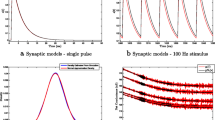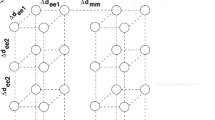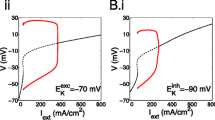Abstract
Generation of epileptiform activity typically results from a change in the balance between network excitation and inhibition. Experimental evidence indicates that alterations of either synaptic activity or intrinsic membrane properties can produce increased network excitation. The slow Ca2+-activated K+ currents (sIAHP) are important modulators of neuronal firing rate and excitability and have important established and potential roles in epileptogenesis. While the effects of changes in sIAHP on individual neuronal excitability are readily studied and well established, the effects of such changes on network behavior are less well known. The experiments here utilize a defined small network model of multicompartment pyramidal cells and an inhibitory interneuron to study the effects of changes in sIAHP on network behavior. The benefits of this model system include the ability to observe activity in all cells in a network and the effects of interactions of multiple simultaneous influences. In the model with no inhibitory interneuron, increasing sIAHP results in progressively decreasing burst activity. Adding an inhibitory interneuron changes the observed effects; at modest inhibitory strengths, increasing sIAHP in all network neurons actually results in increased network bursting (except at very high values). The duration of the burst activity is influenced by the length of delay in a feedback loop, with longer loops resulting in more prolonged bursting. These observations illustrate that the study of potential antiepileptogenic membrane effects must be extended to realistic networks. Network inhibition can dramatically alter the observations seen in pure excitatory networks.
Similar content being viewed by others
References
Alger BE, Nicoll RA (1980) Epileptiform burst afterhyperolarization: calcium-dependent potassium potential in hippocampal CA1 pyramidal cells. Science 210:1122–1124
Beck H, Blümcke I, Kral T, Clusmann H, Schramm J, Wiestler OD, Heinemann U (1996) Properties of delayed rectifier potassium current in dentate granule cells from the hippocampus of patients with chronic temporal lobe epilepsy. Epilepsia 37:892–901
Behr J, Gloveli T, Heinemann U (2000) Kindling induces a transient suppression of afterhyperpolarization in rat subicular neurons. Brain Res 867:259–264
Bernard C, Cossart R, Hirsch JC, Esclapez M, Ben-Ari Y (2000) Physiological modifications in hippocampal CA1 interneuron in experimental epilepsy result in their hyperactivity. Epilepsia 41(Suppl 7):A10
Bhalla US, Bower JM (1993) Exploring parameter space in detailed single neuron models: simulations of the mitral and granule cells of the olfactory bulb. J Neurophysiol 69:1948–1965
Biervert C, Schroeder BC, Kubisch C, Berkovic SF, Propping P, Jentsch TJ, Steinlein OK (1998) A potassium channel mutation in neonatal human epilepsy. Science 279:403–406
Borde M, Bonansco C, Buno W (1999) The activity-dependent potentiation of the slow Ca2+-activated K+ current regulates synaptic efficacy in rat CA1 pyramidal neurons. Pflugers Arch 437:261–266
Borde M, Bonansco C, de Sevilla F, Le Ray D, Buno W (2000) Voltage-clamp analysis of the potentiation of the slow Ca2+-activated K+ current in hippocampal pyramidal neurons. Hippocampus 10:198–206
Deyo SN, Lytton WW (1997) Inhibition can disrupt hypersynchrony in model neuronal networks. Prog Neuropsychopharmacol Biol Psychiatry 21:735–750
During MJ, Ryder KM, Spencer DD (1995) Hippocampal GABA transporter function in temporal-lobe epilepsy. Nature 376:174–177
Empson RM, Jefferys JGR (2001) Ca2+ entry through L-type Ca2+ channels helps terminate epileptiform activity by activation of a Ca2+ dependent afterhyperpolarization in hippocampal CA3. Neuroscience 102:297–305
Freund TF, Buzsáki G (1996) Interneurons of the hippocampus. Hippocampus 6:347–470
Gao TM, Fung ML (2002) Decreased large conductance Ca(2+)-activated K(+) channel activity in dissociated CA1 hippocampal neurons in rats exposed to perinatal and postnatal hypoxia. Neurosci Lett 332:163–166
Kwan P, Sills GJ, Brodie MJ (2001) The mechanisms of action of commonly used antiepileptic drugs. Pharmacol Ther 90: 1–34
Martin ED, Araque A, Buno W (2001) Synaptic regulation of the slow Ca2+-activated K+ current in hippocampal CA1 pyramidal neurons: implication in epileptogenesis. J Neurophysiol 86:2878–86
McBain CJ (1995) Hippocampal inhibitory neuron activity in the elevated potassium model of epilepsy. J Neurophysiol. 73:2853–2863
Moshe SL (2000) Mechanisms of action of anticonvulsant agents. Neurology 55(5 Suppl 1):S32–S40; discussion S54–S58
McQuiston AR, Madison DV (1999) Muscarinic receptor activity induces an afterdepolarization in a subpopulation of hippocampal CA1 interneurons. J Neurosci 19:5703–5710
Olsen RW, Avoli M (1997) GABA and epileptogenesis. Epilepsia 38:399–407
Pedarzani P, Krause M, Haug T, Storm JF, Stühmer W (1998) Modulation of the Ca2+-activated K+ current s IAHPP by a phosphatase-kinase balance under basal conditions in rat CA1 pyramidal neurons. J Neurophysiol 79:3252–3256
Pinsky PF, Rinzel J (1994) Intrinsic and network rhythmogenesis in a reduced Traub model for CA3 neurons. J Comput Neurosci 1:39–60 Erratum in: J Comput Neurosci 2(1995):275
Prince DA (1978) Neurophysiology of epilepsy. Annu Rev Neurosci 1:395–415
Protopapas AD, Vanier M, Bower JM (1998) Simulating large networks of neurons. In: Koch C, Segev I (eds) Methods in neuronal modeling, 2nd edn. MIT Press, Cambridge, MA pp 461–498
Sah P (1996) Ca2+-activated K+ currents in neurons: types, physiological roles and modulation. Trends Neurosci 19:150–154 (review)
Traub RD, Jefferys JGR, Miles R, Whittington MA, Tóth K (1994) A branching dendritic model of a rodent CA3 pyramidal neuron. J Physiol Lond 481:79–95
Traub RD, Wong RK, Miles R, Michelson H (1991) A model of a CA3 hippocampal pyramidal neuron incorporating voltage-clamp data on intrinsic conductances. J Neurophysiol 66:635–650
Treiman DM (2001) GABAergic mechanisms in epilepsy. Epilepsia 42(Suppl 3):8–12
Verma-Ahuja S, Evans MS, Pencek TL (1995) Evidence for decreased calcium dependent potassium conductance in hippocampal CA3 neurons of genetically epilepsy-prone rats. Epilepsy Res 22:137–144
Yang K-H, Franaszczuk PJ, Bergey GK (2002) The influence of synaptic connectivity on the pattern of bursting behavior in model pyramidal cells. Neurocomputing 44–46:233–242
Yang K-H, Franaszczuk PJ, Bergey GK (2003) The influences of somatic and dendritic inhibition on the patterns of bursting in a neuronal circuit model. Biol Cybern 89:242–253
Zhang L, McBain CJ (1995) Potassium conductances underlying repolarization and after-hyperpolarization in rat CA1 hippocampal interneurones. J Physiol 488:661–672
Acknowledgments.
This research is supported by NIH grant NS38958. A preliminary version of this work was presented at the Computational Neuroscience 2003 meeting.
Author information
Authors and Affiliations
Corresponding author
Rights and permissions
About this article
Cite this article
Yang, KH., Franaszczuk, P. & Bergey, G. Inhibition modifies the effects of slow calcium-activated potassium channels on epileptiform activity in a neuronal network model. Biol Cybern 92, 71–81 (2005). https://doi.org/10.1007/s00422-004-0532-0
Received:
Accepted:
Published:
Issue Date:
DOI: https://doi.org/10.1007/s00422-004-0532-0




